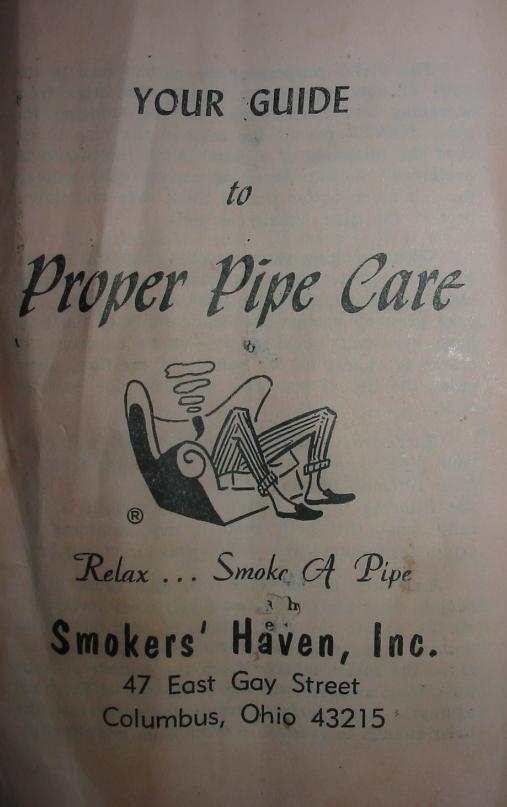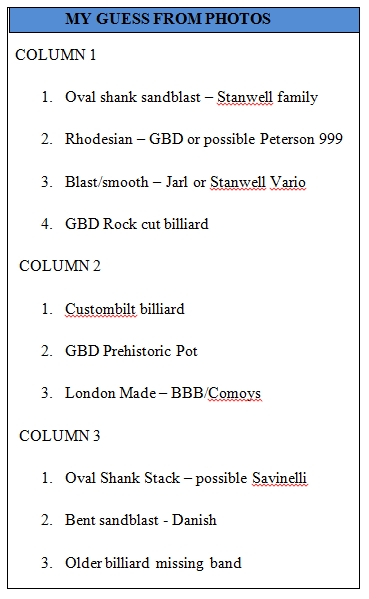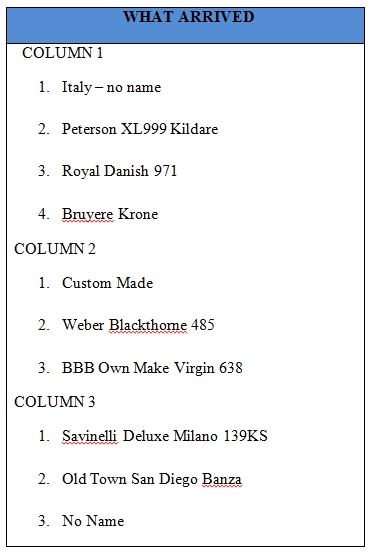Blog by Martin Farrent
I read this awhile back on the web and wrote Martin for permission to post it on the blog. I find his work helpful in dating Loewe pipes and a pleasure to read. I received his permission last evening so here is his article.
Loewe is one of the haunting old names of British pipe-making, characteristic of an almost vanished upper middle class” of the trade, which also incorporated makes such as BBB, Orlik, Comoy’s and GBD. Along with these brands, Loewe has long dwindled into pseudo-existence, becoming little more than a logo occasionally used by the Cadogan factory in Southend-on-Sea. But owners of older Loewes treasure them as superb, featherweight smokers, excellently crafted and with grain characteristics superior to those of many contemporary Dunhills.
The Frenchman Emil Loewe founded the company, both shop and workshop, in 1856 at the Haymarket 62, London. He is said to have been the first to make briar pipes in England. Richard Hacker maintains that theatre people from the West End were among the shop’s heyday aficionados. Loewe’s spigots are especially well regarded by lovers of elegance today – they were originally introduced for practical reasons, to facilitate the production of replacement stems for customers abroad.

The firm and its facilities were later taken over by Civic, well before becoming a fully integrated part of the Cadogan group sometime in the final quarter of the twentieth century. As with other brands belonging to this group, it is not easy to pinpoint a date marking the end of Loewe’s independence and singularity. This is partly due to Cadogan’s own development from a cooperative to a monolithic entity.
In 1979, a German paperback said that the Loewe brand had been discontinued two years previously, but that the pipes themselves were due to reappear as high-end GBDs. Interestingly, the year of publication coincided with the year in which the Loewe trademark became Cadogan’s, who by this time already owned GBD. From today’s point of view, the author appears to have been working on confused, but partly true information. If there were ever really plans to fully amalgamate the two lines, they were dropped. Also, a two-year break at this time seems impossible, since we have hallmark evidence of Loewes made in 1978 and 1979. However, there are firm indications that Loewe shapes were later marketed as Comoy’s (another Cadogan brand). There may also have been a phase of dissolution regarding location. The reported appearance of French Loewes in the early 1980s is a sign that Loewes were being produced in more than one place at some stage before the Cadogan-era proper.
From what I can gather, Cardogan’s various brands continued to be made in separate facilities throughout the1970s. It was the purchase of Orlik in 1980 that enabled the Cadogan group to consolidate all manufacturing in that company’s new factory in Southend-on-Sea. Whether or not this transferal was a gradual process and when it affected Loewe is unclear. We hear that, as a company, Loewe was not formally wound up by Cadogan (the successor to Civic) until the late 1980s. Of course, today’s ‘Loewes’ are definitely made in Southend – though, according to Cardogan, the trademark is no longer used very much.
Collectibility
As with most brands now owned by Cadogan, the collector’s emphasis is on finding pieces made before the consolidation of the group’s production in the Southend factory. It is generally agreed, for example, that the loss of a separate identity spelled the end of GBD’s excellence. Likewise, the once celebrated name Orlik means little to the buyer of new pipes today. But finding an ‘original’ on the estate market often involves blind trust in a vendor’s word — or in one’s own ability to assess a pipe’s quality from a couple of photos on Ebay.
Mounted Loewes are thus the most valued, since the hallmarks on their silver bands offer an indication of age. Other pipes bearing the ‘L&Co’ logo are impossible to date as exactly as older Dunhills or even Charatans, where frequent changes to stamping patterns have been well documented. By contrast, the various owners of the Loewe trademark appear to have adhered to the original patterns rather consistently.
With help from members of the pipe-smokers’ newsgroups ASP and DAFT (Germany), I have looked into ways of rectifying this situation. We have come a little closer to dating Loewe pipes — or at least assigning them to a period, but there are gaps. One method is to correlate stamps with the hallmark information on pipes with bands, giving an idea of the exact stamp used in a given period. However, for a complete dating guide we would need to have examples from years clearly marking the beginning or end of a certain stamping policy — and also more insights into ownership and location issues.
To an extent, Cadogan have been helpful with information, but they have not answered historical questions. Also, their stamping philosophy really adds to the confusion. For example, they still use a London stamp, though production has been on the Essex coast for well over a decade, possibly two. The results of our collected research are still not comprehensive and the hope remains that someone will provide the information necessary to fill in the blanks.
Aspects of Dating
The period of transitions — and therefore of interest, here — begins some time after 1960. Around that year, the pipes were still being made in the Haymarket building, though – of course – no longer by the late Emil himself. Civic was running the business, apparently having taken over from the founder or his successors under a mutual agreement many years previously. There is no indication that the pipes made under Civic ownership at this time were any less highly regarded than earlier Loewes.
Based on information rendered by owners of hallmarked Loewe pipes, the stamping from 1920
(or earlier) to 1967 (or slightly earlier) appears as follows:

* The first series names to be used appear to be ‘CENTURION’ and ‘ORIGINAL’ and ‘OLD ENGLISH’. According to catalogues, they denote grades. Centurions were allegedly made of wood over 100 years old. Grading was not introduced until some time between 1956 and 1964, as one Danish owner of Loewe catalogues reports. Additional, probably later, grade stamps include ‘MOUNTED’, ‘SPIGOT’, ‘STANDARD’ and ‘STRAIGHT GRAIN’. There are certainly no grade stamps on pipes made up to 1920. There were also none on the sandblast pipes advertised as Ripple Grains in 1950. That year’s catalogue also lists a pipe called the “Process”, with a natural finish and a processed bowl requiring no breaking- in. Both the Process and the blasts were missing in 1956.
During the 1960s, still under the Civic regime, the original premises were lost to development schemes, and Loewe pipes were made in various, (possibly successive) locations all over London (Hammersmith appearing to be one of them).
Also, at some stage before 1968, shape names were replaced by shape numbers, apparently all incorporating three digits and beginning with a 9. For example, a 910 was a billiard. We know that these numbers, stamped on the right side of the shank (under ‘LONDON W.’), were still used in 1983, though there is some confusion about this. We do not know exactly when the switch from names to numbers took place. It could have been as late as 1967, but may have occurred a few (not many) years earlier. A shape name appeared on a new pipe bought in the USA in 1967, yet a pipe bearing that year’s hallmark on its band already displays a number, rather than a name. It’s also worth noting the recollections of one Danish smoker, who remembers that W.O. Larsen only imported Loewes to Denmark until 1968.
Manfred W. Resag has a page on 9xx numbered pipes, with photos of pieces made from 1978 to 1982 (with one possible exception — an unbanded and therefore undateable pipe):
http://perso.wanadoo.fr/nautor/Loewe.htm
By studying the website of one UK dealer I was able to deduce that the present shape numbers (early 2003) mostly (probably all) differ from those used from 1967. For example, a Billiard is now a 28, a Lovat an 834, a Canadian a 296. Some shape numbers now have 4 digits. But even today, Cadogan will occasionally still stamp a pipe with a shape name instead of a number, though only on request.
It would appear that both older pipes with shape names and pipes using the 9xx numbers were made in London, before the move to Southend. My guess is that only the pipes made prior to the introduction of numbers were carved on the original Haymarket premises, with the graded shanks (series names) probably indicating pieces carved after 1956.
Murky issues
To go some way towards verifying this theory, we would need to know the exact year of the move from the Haymarket, but also more about the stamps on pipes made between 1960 and 1966/67. All those smokers who followed a call for information in ASP and DAFT and reported dateable (hallmarked) pipes owned pieces made before or after these years, which almost certainly encompassed the loss of the Haymarket workshop.
Cadogan has not answered questions concerning this or the later move to Southend. However, from the evidence contributed by readers of the first version of this article, I would say that the second event occurred by or in 1982, the year in which a Danish collector has reported buying a Canadian with the new 296 shape number.
This is notwithstanding the fact that several people own Loewes with the 9xx stamps — pipes I would attribute to the late London days — yet with hallmarks from 1982 or even 1983. There are several conceivable explanations for this. The most obvious is that there may have been a few months of overlapping production in two or more locations. One could even raise the question of whether the later London years saw any consolidated product ion at all — or whether some (or all) Loewes were being made to order by other firms. The Danish collector mentioned above has records of being offered both London-made and (cheaper) French Loewes in 1982.
Moreover, it is also reasonable to assume that some pipes began life in London and were stamped there, but only completed in Southend. In a few cases, it even seems clear that the lapse between conception and completion was several years. For instance, one German smoker owns a 908 with a 1983 hallmark. It was from a strange batch of spigots offered by a German dealer in the late 1990s, with shank bands hallmarked in the early 1980s and stems made a dozen or so years later. The dealer remembers that they were the last Loewes ever offered to him. Curiously, some of the Loewe shapes from the 1970s and early 1980s apparently reappeared as Comoys (now also made by Cadogan), later on. Indeed, Comoy spigots were among the new series introduced after Comoy’s full integration into Cadogan. This was in line with Cadogan’s branding hierarchy, which put Comoy’s at the top of the pyramid at some expense to the prestige of the other names. So an educated guess says that the bowls of the strange Loewes in question
were made in London, were among the inventory moved to Southend and fitted with stems years later, when someone remembered or discovered them. The stems were available, because they were still being produced for the new Comoy pipes.
One final note on the transition period regards the desirability of Loewes made between the Haymarket days and the move to Southend. I have yet to hear a complaint from an owner of one of these pipes. I have a fine mounted Rhodesian myself with excellent, almost straight grain. It is a superlative smoker.
Prices
In 1926, the wholesale price for an unmounted Loewe was 11 shillings and three pence. 24 years later, it had doubled and such a pipe retailed for 50 shillings. At this time (1950) an ounce of pipe tobacco or a 4lb loaf of bread cost an average of a shilling in London. In 1982, one dealer was offering Loewes (London) for 19.50 pounds. A batch of 9xx Loewe spigots made in the early 1980s and sold towards the end of the century cost around 200 Euros each in Germany. In early 2003, one British website advertised Loewe-Kaywoodies for 18.50 to 65.00 pounds sterling (about 27 to 95 Euro/$). These were Cadogan pipes, of course. At the same time, some ‘antique’ pieces were fetching up to 175 Euro or US $.
Early Loewes were available with a variety of options, such as amber stems and solid silver or gold mounts at a surcharge. Interestingly, the 1926 catalogue prizes the pipes’ “natural finish”, but adds that an attractive dark tan was available at no extra charge (!).
Acknowledgements and note
This article grew in the making, following requests for information on Usenet and the publication of a first version, which almost immediately hastened new input from readers. My thanks to Asp’ers Kevyn Winkless, Stephen Bozle. Greg Pease, Chris Keene, Manfred Resag, Sonam Dasara, Jorgen Jensen and Jesper of Danpipes for contributing information and ideas to this article. Valuable details were also reported by DAFT (German newsgroup) members such as Klaus J. Pfeifer, Manfred Arenz, HaJo Oestermann, Jörg Eichelberger, Rainer Duesmann, Joachim Acker and Michael Karrengarn.
Finally, though I include my e-mail address here, it is not really intended for queries, since I lack the knowledge to answer them. I am simply an admirer, but no expert on Loewe pipes and have included every last scrap of evidence I have accumulated in this article. So ideally, the address is for those able to contribute additional information in order to make this text more satisfactory, some day.
Martin Farrent March 2003
martin@farrent.de




















































































































































